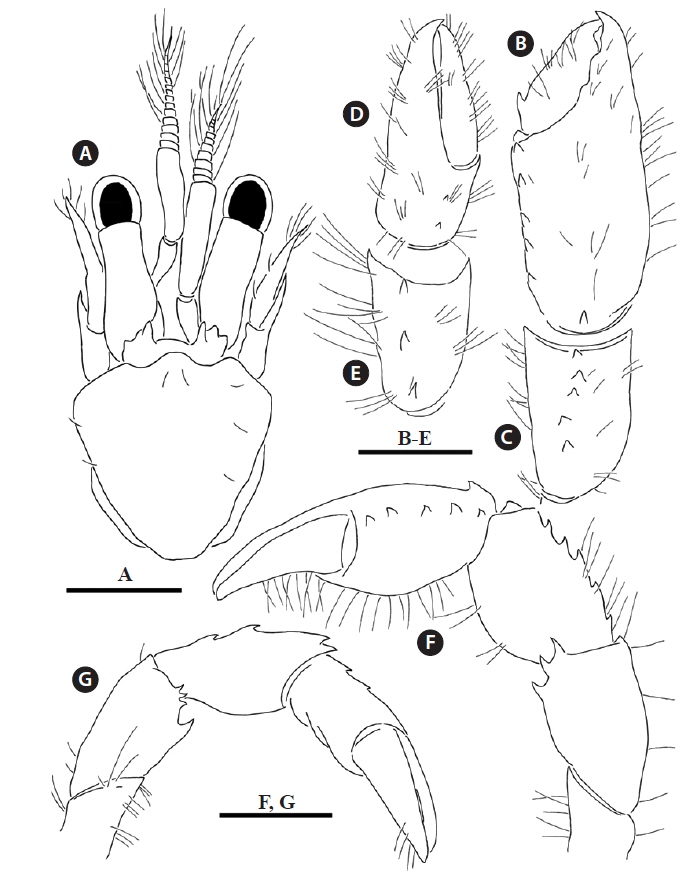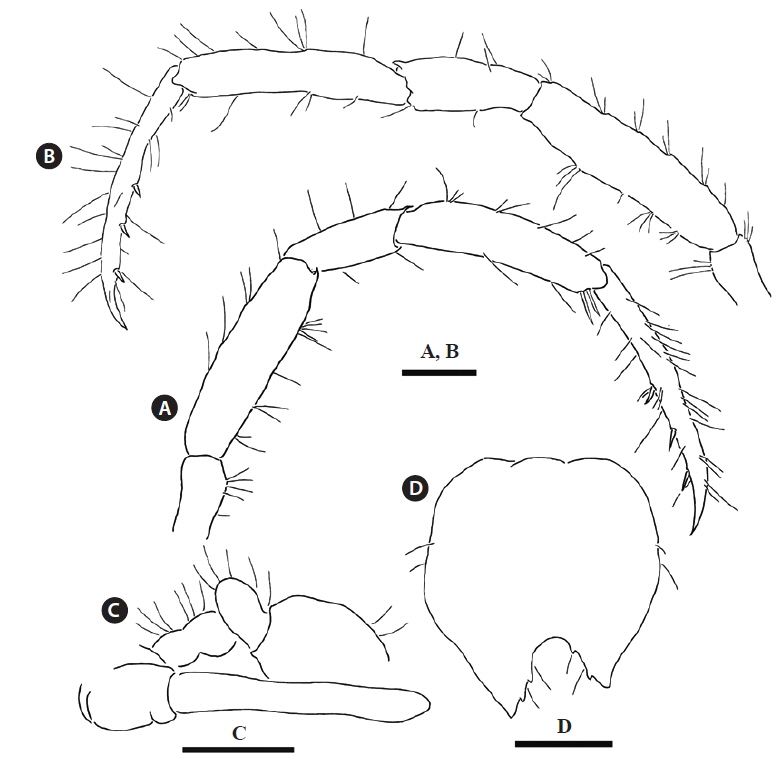The genus Catapaguroides A. Milne-Edwards and Bouvier, 1892 has not been extensively reported. Because most species are very small, and live at depths in excess of 50 m, they cannot be easily collected. Although Catapaguroides of the worldwide is known to 29 species, most have been described on the basis of only a few specimens, and their ecology is largely unknown (McLaughlin, 2002; Komai and Rahayu, 2013; Komai, 2014). In the Korean waters, no Catapaguroides species had been reported, although 8 species are known from the adjacent Japanese waters (Komai, 2014). During recent collections along Jeju Island, Korea in 2014, a pagurid hermit crab, Catapaguroides fragilis (Melin, 1939) was collected 4 specimens by a van Veen grab sampler from sandy bottoms at depths of 10 m. This species is the first member of Catapaguroides known from Korea. A morphological description and illustration of this species are given.
Specimens examined in this study have been deposited at the OceanTech Marine Institute (OTMI), Busan. Shield length (SL) is used as an indication of specimen size, measured from the tip of the rostrum to the midpoint of the posterior margin of the shield. For detailed observations of the integument surface structure, the specimens were stained with methylene blue. Terminology used here is mainly based on that of McLaughlin (2003).
Order Decapoda Latreille, 1802
Family Paguridae Latreille, 1802
Genus Catapaguroides A. Milne-Edwards and Bouvier, 1892
Catapaguroides fragilis (Melin, 1939)
(Korean name: Eolruk-kkoma-chamjipge ) (Figs. 1, 2)
Eupagurus (Catapagurus) fragilis Melin, 1939: 45, Figs. 23-26.
?Catapagurus setosus Edmondson, 1951: 200, Fig. 9.
Catapaguroides fragilis: De Saint Laurent, 1968: 940, Fig. 26; Miyake, 1978: 134 (in part); McLaughlin, 2002: 499 (key); McLaughlin and Pittman, 2002: Fig. 1E; Okuno and Arima, 2006: 35, Fig. 3; Komai and Rahayu, 2013: 157, 144 (Table), 187 (key).
[Fig. 1.] Catapaguroides fragilis (Melin, 1939). Male (SL 0.91 mm, OTMI 102). A, shield and cephalic appendages, dorsal; B, chela of right cheliped, dorsal; C, carpus of right cheliped, dorsal; D, chela of left cheliped, dorsal; E, carpus of left cheliped, dorsal; F, entire right cheliped, mesial; G, entire left cheliped, mesial. Scales: A-G = 0.5 mm.
[Fig. 2.] Catapaguroides fragilis (Melin, 1939). Male (SL 0.91 mm, OTMI 102). A, right second pereopod, lateral; B, left third pereopod, lateral; C, coxae of fifth pereopods, showing sexual tubes, ventral; D, telson. Scales: A, B = 0.3 mm, C = 0.25 mm, D = 0.12 mm.
Material examined South of Jeju Island (33°14.073´N, 126°32.650´E); depth of 10 m; a van Veen grab sampler, March 2014; three males (SL 0.91-0.94), one female (SL 0.94 mm), OTMI #102.
Shield slightly longer than wide. Rostrum broadly rounded, slightly overreaching obsolete lateral projections. Ocular peduncles long and slender, shorter than shield. Antennular peduncles exceeding distal corneal margins by 0.3-0.5 times of the length of the ultimate segment. Antennal peduncles reaching approximately to distal corneal margins (Fig. 1A). Chelipeds distinctly unequal and dissimilar, and the right cheliped is larger than the left cheliped. Right cheliped with dactylus shorter than palm, with a single small spine proximally, and mesial margin rounded dorsomesially, dorsal surface with numerous long setae; palm elongate, approximately uniform from proximal to distal margin, dorsolateral margin with row of five longitudinal spines, dorsolateral margin unarmed, dorsoproximal margin with a prominent spine, dorsal surface with numerous long setae, carpus with row of five longitudinal dorsomedial spines (Fig. 1B, C, F). Left cheliped with dactylus slightly longer than palm, unarmed but with numerous long setae; palm shorter than carpus, dorsomesial margin with two spines, dorsal surface with long setae; carpus with three dorsomesial spines, dorsal surface with long setae (Fig. 1D, 1E, 1G). Ambulatory legs longer than right cheliped; dactyli unarmed with long stiff setae on dorsal surface, each ventral margin with row of corneous spines; propodi with two short to long, basally articulated bristles on ventrodistal margin (second) or unarmed (third) on dorsal and ventral surfaces; carpi with dorsodistal spinule (Fig. 2A, 2B). Right male sexual tube elongate, reaching beyond coxa of left fourth pereopod; left sexual tube very short (Fig. 2C). Telson with slightly asymmetrical, narrow, posterior lobes separated by deep median cleft; terminal margins each with two small spines, one slightly curved spine at posterolateral angle (Fig. 2D).
Southern Japan, Mururoa, depths of 22-75 m (Komai and Rahayu, 2013). South of Jeju Island, Korea, depth of 10 m (the present study).
The present specimens match the definition of the species by de Saint Laurent (1968), McLaughlin (2002), and Komai and Rahayu (2013) who reported the morphological characters of C. fragilis as follows: the dorsomesial margin of the dactylus of the right chela is not delimited; the palm of the right chela is not particularly widened distally and bears a dorsomesial row of small spines and one prominent proximal spine on the dorsal surface; the dorsolateral margin of the palm of the right chela is not delimited; and the carpus of the right cheliped bears a row of spines on the dorsolateral margin. However, the present specimens are different in having the dactylus of the left cheliped slightly longer than the palm, and the telson with two small spines on both terminal margins. De Saint Laurent (1968) noted that the terminal margins of the telson bears three spines. However, Komai and Rahayu (2013), who exam-ined one female of C. fragilis from Tanegashima Island Japan, found an unarmed left terminal margin, and a right terminal margin with one very small spine. Thus, the differences in the telson may be attributed to interspecific variation. However, it is difficult to attribute differences in the length of the dactylus of the left cheliped to intraspecific variation because only a few specimens were collected. C. fragilis is usually collected from depths of 22-75 m (Komai and Rahayu, 2013), but the present records extend the depth range to 10 m.





